A Review of the Fenn Spark,
As Compared to the Stellar SES
Sept 2014
by Bill LeComte
I have had the Fenn Spark/Carbon-Hybrid for about 3 weeks now. I’ll start right off by saying I am very impressed with the boat. Note: I have no connection to any surfski manufacturer/seller. This is my attempt to be objective, and yet, of course, it can’t help but be a subjective and personally biased opinion based on my own experiences and requirements.
My background – I have been paddling skis for 7 years now and have a few skis (Legend, Evo, SES) (Ever notice? Surfskis are like potato chips – you can’t have just one!) One of these is a Stellar SES/Excel that I have hundreds of hours on, virtually all in the ocean and in all conditions up to 25-30 knot winds and the corresponding seas, so that is my primary reference point for comparison with the Spark as I consider them both in the same class in performance and design (i.e., elite level skis for the smaller sized paddler).

I certainly do not consider myself an advanced paddler in terms of racing, because I don’t much race or train, but in terms of rough seas I will generally head out in anything we get in this locale and seek the challenges of surfing the biggest conditions I can find. Here in New England of the U.S. we don’t get the continuous winds developing huge seas that other areas of the world enjoy (and I admit I am fairly envious of that), but, we occasionally get 15-20 knots plus blowing off the ocean for hours at a time leading to 5-7 foot (1.5 – 2 m) seas and sometimes higher if there is an offshore storm (with some significant cognitive dissonance I look forward to hurricane season every year for the big seas, despite the continuing rise of my homeowners insurance). I am 140 lbs (63.5 kg) and so have been very happy that the last few years have seen the ski builders designing and getting lower volume high performance skis into the marketplace; I know first-hand the challenges of a low volume guy trying to turn a high volume ski into a 25-30 knot wind. As my whole goal on skis is to paddle big stuff downwind, any ski I get now needs to perform well in the rough.
I had been seriously considering getting the new Epic V10L as I like the design features, look, brand performance, etc. As Wesley had both on hand, he was kind enough to let me paddle the Spark and the V10L side-by-side (both up and downwind in light seas). In fact, he made sure I paddled both in the same conditions; Wesley is a guy who wants everyone in “the right boat”, not just the one they think is right. The fact that he has owned and paddled many, many skis makes him quite a resource when it comes to distinguishing the nuances of each. Since I only paddled the V10L that day I of course cannot evaluate it fully; but, I ultimately chose the Spark. Mostly because I felt the Spark was noticeably quicker in getting up to speed and onto the bumps. While the V10L is more stable, I believe I now have the stability to be in the Spark and utilize the increased quickness it has. I still think the V10L is a great boat, and if I was transitioning from an intermediate ski or certainly a beginner ski I would have chosen the V10L.
So now my thoughts on the Spark, mostly as compared to the SES, and, mostly in terms of overall performance “in-the-rough” (being seas higher than about 3 feet, the performance area I most care about):
Comfort – while everyone’s glutes and hips are sized and shaped differently, this bucket is just fine for mine, no problems at all even after a couple hours on a warm day (from my experience, hot no-wind days really test comfort in skis as the increased circulation at the outer skin layer required for cooling will exacerbate any normally hidden problems). It has a nice narrow bucket, maybe 14 ¾ inches at the wide point; still, I added a bit of minicell on each side as it gives my practically non-existent hips even less room to slide around. The cockpit holds my legs just right for max drive – no splaying of the knees allowed in this narrow channel. The hump must be just right for me because I had not even thought about it until I wrote this. Similarly, the SES has been comfortable for me; at this point I can’t really see a difference in comfort between it and the Spark (although, I still give my Think boats the highest marks for comfort; kind of like sitting on a soft leather couch – ok, not quite that comfortable, but you get what I mean).
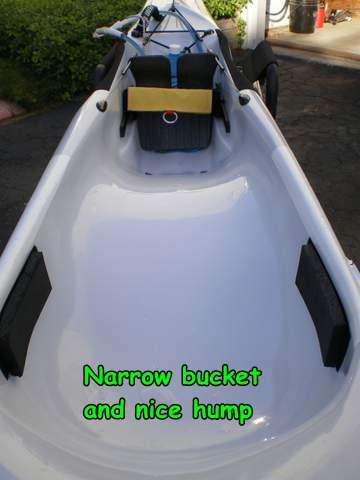
Build – No problems, everything appears to be fine. I have not weighed it, but I suspect it is lower than that advertised weight of 26 lbs (11.8 kg). No bungee attachments on the aft deck, but that is OK as they are easy enough to install. To compare, the SES has a really strong build – it has always felt more “solid” as compared to any other ski I have been around. As with the SES, both have foot pedal assemblies that are rock-hard, suitable for really pushing with the leg drive. The pedals require the allen wrench on the Spark for adjustment, a minor annoyance, but the plus side is the steel lines make them really easy to get the rudder centered when adjusting. On the SES, I changed the rudder lines to Q-power as it has less stretch than the OEM dyneema, and, made the two lines independently adjustable as they tie off on cleats on the pedal backs – I feel it makes it a bit easier to adjust the pedals and center the rudder.
Rudder and steering – The Spark stock rudder (about 8” long – kind of a cross between a weedless and an elliptical) is fine in the seas I have had it in so far (up to 5 feet (1.5 m)), but I’ll probably have a 9 inch elliptical made for when the seas are larger. I honestly do not think the steering could be more responsive (no doubt at least partly due to the steel cables); this is great when on waves requiring the right track for the link to the next one. You need to train yourself not to over-steer on this ski as it is so sensitive (if I sneezed I think I would probably change my course by 45 degrees). The SES has some delay when you input steering moves, but that has forced me to learn “body-English” moves to coax it onto the right track on large waves (note to Stellar – consider moving the rudder back a couple inches, that might significantly increase the steering control without hampering downwind performance).
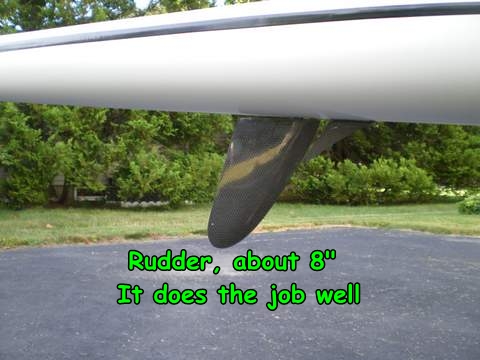
Remounting – I find remounting on the Spark neither harder nor easier than any other ski I have been on; that said, I have never had any problems remounting any ski, having spent the first year or so of my surfskiing life being forced to develop this critical skill while remounting many, many, times (mostly all unscheduled) in pretty much every conceivable set of conditions.
Stability – Slightly less than my SES, but not so much to make it uncomfortably unstable for me. As with all new skis for me, there is a short stability adjustment learning curve; however, already after only around maybe 20 hours on it – I feel much more stable in higher seas now than the first time I paddled it in light conditions. In fact, I’d bet that in a couple more sessions in rough water I will be completely at home in it.
Catching runs – So far, due to the nimble acceleration, I think this is the best boat I have for catching runs: the weight, hull shape, narrow beam, and the close catch on the Spark all combine to noticeably allow more acceleration, especially in the first part of the stroke. I am glad to see that ski designers are now evolving their designs to incorporate the hull shaping improvements to get the close-as-possible catch. That is one design feature I hope is incorporated into all new skis. With the Spark, I feel as if I can catch any wave I want to. This is a fantastic feeling and is really the single most important reason I like the ski.
Overall speed – not sure on this one. At first, I though the Spark was faster, but I think that may have had something to do with “new ski excitement syndrome”; you probably know how that is. I think it and the SES are about the same or at least close enough where I can’t really tell. Without controlled lab testing I think it will always be practically impossible to be sure as there are just so many variables. So, for me, so long as I can catch runs and one ski isn’t a garden slug compared to the other, it comes down to how one “feels” on a ski being the most important factor. I make the argument that the Spark accelerates faster, which, all things being equal, should contribute to an overall increase in speed – perhaps; but as I paddled both it and the SES hard in lesser wave conditions my average speeds appeared to about match. I’ll leave it to all of you who time trial them to tease out the winner.
Broaching (the tendency of a ski to turn broadside when on a large wave) and pearling (submerging of the bow on a high speed steep runner) – I have only had it in 5+ foot (1.5 m) seas for a limited amount of time so far, 5 foot waves and higher being the point where I feel broaching and pearling can become an issue. While I have gotten much better in the SES of avoiding broaches after adding an elliptical rudder, using lower-stretch synthetic lines, and gaining more experience in it, the Spark just does not seem have any broaching tendencies at all. As lower volume skis, I thought both of them might be more subject to pearling in heavy seas but have not found that. On the Spark, the ability to avoid broaching may be partly because the responsive steering allows minor course correction as I track down the wave (and, of course, as time goes by hopefully the operator of these skis has improved a bit as well so that what once may have been problems no longer occur).
Confused washing-machine messy chop performance (you know, the stuff created by several big sport fisherman and giant zillion dollar yachts ripping by at different angles near rock walls creating those super steep refracting 3 – 5 foot waves coming from six different directions at the same time) – As good as you can expect for a skinny boat. The SES comes out slightly ahead here as the secondary stability of it is just so good for a narrow ski. But, as I get more adjusted in the Spark, I suspect the differences will fade.
“Big water” performance – My definition for seas of about 8 feet (2.5 m) and higher. I have not had those conditions to go out in since I got the Spark, as that would take a large offshore storm to generate around here. I have been in the SES in that stuff quite a number of times – it performs well, and, one other thing is almost certainly true: for the weight, the SES is probably about as bomb-proof a surfski as one could get. The lighter weight of the Spark means it probably has to give up some strength somewhere (?), and, since there is no problem catching runs when in really big water and the SES is slightly more stable, for the time being the SES will normally be my ski of choice for those circumstances.
Cockpit draining – The dual venturis work well, these combined with a relatively low volume cockpit make draining a non-issue with the dreaded cockpit swamping when the wave crest breaks on you (there is some open room forward of the pedals as set for my leg length, but what is not taken up by my water bladder will eventually be filled with closed-cell foam if needed). The SES has always suffered from less than adequate drainage – I have gotten around that partly by filling pretty much ever cubic inch of open space in the cockpit with closed cell foam, both forward of the pedals and even back where my legs are. Someday perhaps I will add a couple more venturis.
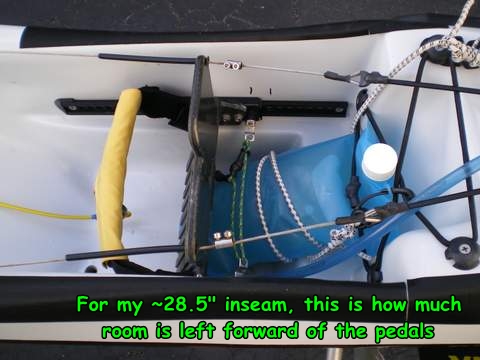
Some other non-performance related comments:
• I wish the Spark had a leash attachment hard point suitable for a body leash, as I consider this a more important feature when on the ocean. Most of the more unfortunate incidents I have read about since I started paddling these have involved paddlers getting separated from their skis. While leg leashes are effective, cycling the velcro every time one uses it inevitably weakens it over time and it therefore should be replaced periodically. Also, I’ve never been keen on potentially having a broadside ski pull hard on my leg, even outside the shore break (while I do not go in or out through the shore break, there are a few places I go where the waves rear up on a shallower bottom transition zone where I’ve had to deal with some breakers) Since the footplate assembly appears to be strong, I modified the foot strap and added a strong attachment point in the center. I use this with a strong self-made body leash attached to a strong D-ring with a quick-release shackle on my PFD.
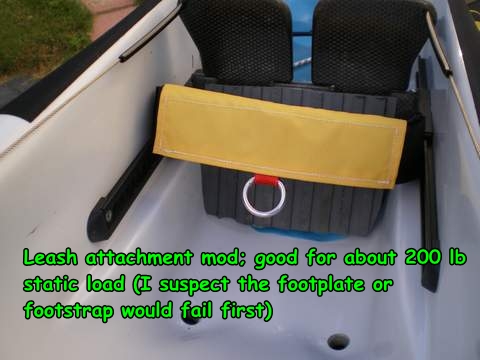
• Rudder box cover – The carbon cover looks sleek, it fits well, but, if one ever has to make a repair at sea it would require a screwdriver to remove the cover to get access to the rudder yoke so you could hook up a bungee or something in the case of a rudder line break. That needs a mod so it can be removed at sea with one hand and no tool; haven’t yet decided what to do there.
• The hand-grip on the forward end of the cockpit – I guess I am not South African, because I just cannot see how this makes it easier to pick up and carry the ski (maybe it works better in the southern hemisphere). But of course this is just personal preference.
To sum up, the bottom line is I really like this boat. This ski is neither too small nor too big for me; it is sized just right (apparently having met the “Goldilocks” design standard). To restate about it what I like most: I feel as if I can catch any wave I want to. It is comfortable, fast as heck, and, I REALLY like paddling it in the rough. It’s a keeper.
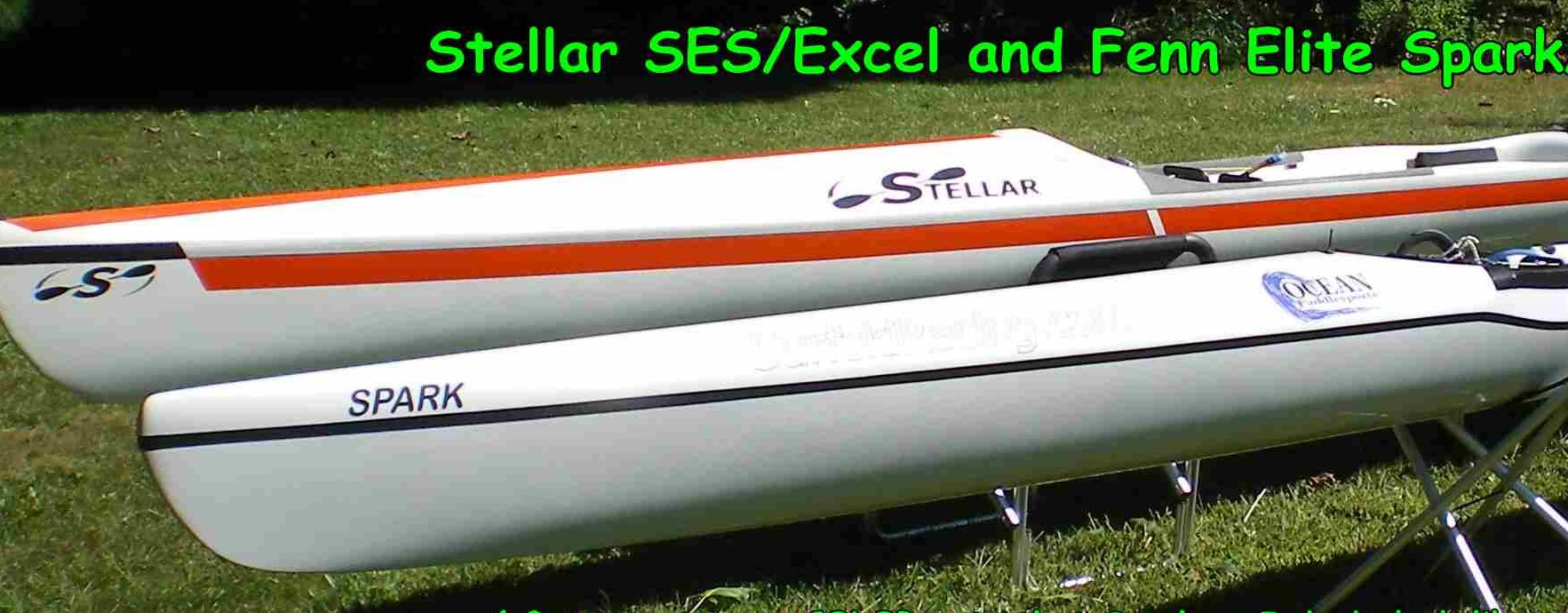
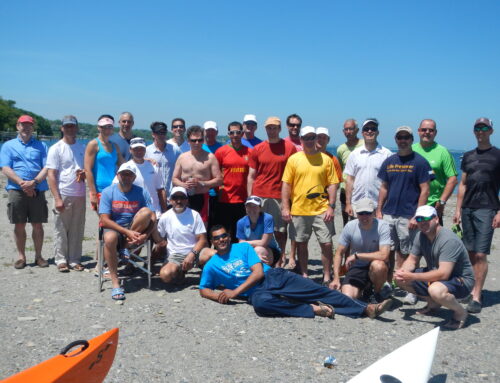
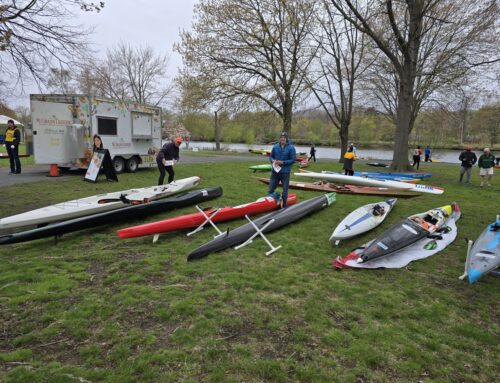
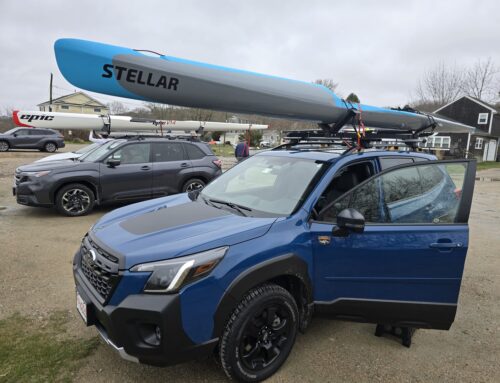
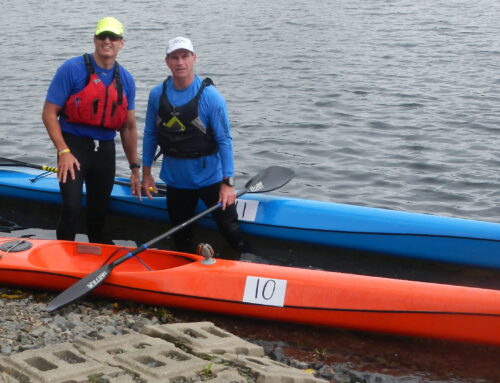
Leave A Comment
You must be logged in to post a comment.